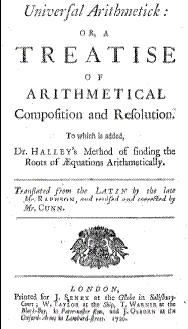
Arithmetica Universalis
Encyclopedia


Mathematics
Mathematics is the study of quantity, space, structure, and change. Mathematicians seek out patterns and formulate new conjectures. Mathematicians resolve the truth or falsity of conjectures by mathematical proofs, which are arguments sufficient to convince other mathematicians of their validity...
text by Isaac Newton
Isaac Newton
Sir Isaac Newton PRS was an English physicist, mathematician, astronomer, natural philosopher, alchemist, and theologian, who has been "considered by many to be the greatest and most influential scientist who ever lived."...
. Written in Latin, it was edited and published by William Whiston
William Whiston
William Whiston was an English theologian, historian, and mathematician. He is probably best known for his translation of the Antiquities of the Jews and other works by Josephus, his A New Theory of the Earth, and his Arianism...
, Newton's successor as Lucasian Professor of Mathematics at the University of Cambridge
University of Cambridge
The University of Cambridge is a public research university located in Cambridge, United Kingdom. It is the second-oldest university in both the United Kingdom and the English-speaking world , and the seventh-oldest globally...
. The Arithmetica was based on Newton's lecture notes.
Whiston's original edition was published in 1707. It was translated into English
English language
English is a West Germanic language that arose in the Anglo-Saxon kingdoms of England and spread into what was to become south-east Scotland under the influence of the Anglian medieval kingdom of Northumbria...
by Joseph Raphson
Joseph Raphson
Joseph Raphson was an English mathematician known best for the Newton–Raphson method. Little is known about his life, and even his exact years of birth and death are unknown, although the mathematical historian Florian Cajori provided the approximate dates 1648–1715. Raphson attended...
, who published it in 1720 as the Universal Arithmetick. John Machin
John Machin
John Machin, , a professor of astronomy at Gresham College, London, is best known for developing a quickly converging series for Pi in 1706 and using it to compute Pi to 100 decimal places.Machin's formula is:...
published a second Latin edition in 1722.
None of these editions credits Newton as author; Newton was unhappy with the publication of the Arithmetica, and so refused to have his name appear. In fact, when Whiston's edition was published, Newton was so upset he considered purchasing all of the copies so he could destroy them.
The Arithmetica touches on algebraic notation, arithmetic, the relationship between geometry
Geometry
Geometry arose as the field of knowledge dealing with spatial relationships. Geometry was one of the two fields of pre-modern mathematics, the other being the study of numbers ....
and algebra
Algebra
Algebra is the branch of mathematics concerning the study of the rules of operations and relations, and the constructions and concepts arising from them, including terms, polynomials, equations and algebraic structures...
, and the solution of equations. Newton also applied Descartes
René Descartes
René Descartes ; was a French philosopher and writer who spent most of his adult life in the Dutch Republic. He has been dubbed the 'Father of Modern Philosophy', and much subsequent Western philosophy is a response to his writings, which are studied closely to this day...
' rule of signs
Descartes' rule of signs
In mathematics, Descartes' rule of signs, first described by René Descartes in his work La Géométrie, is a technique for determining the number of positive or negative real roots of a polynomial....
to imaginary roots. He also offered, without proof, a rule to determine the number of imaginary roots of polynomial equations. Not for another 150 years would a rigorous proof to Newton's counting formula be found (by James Joseph Sylvester
James Joseph Sylvester
James Joseph Sylvester was an English mathematician. He made fundamental contributions to matrix theory, invariant theory, number theory, partition theory and combinatorics...
, published in 1865).

